Skanska Bundle
What Drives Skanska's Success? Unveiling Its Core Principles.
Understanding a company's core principles is key to grasping its potential. This exploration dives into the heart of Skanska, a construction and development giant, to uncover its guiding mission, ambitious vision, and deeply-held core values. Discover how these elements shape Skanska's identity and drive its performance in a competitive global market.
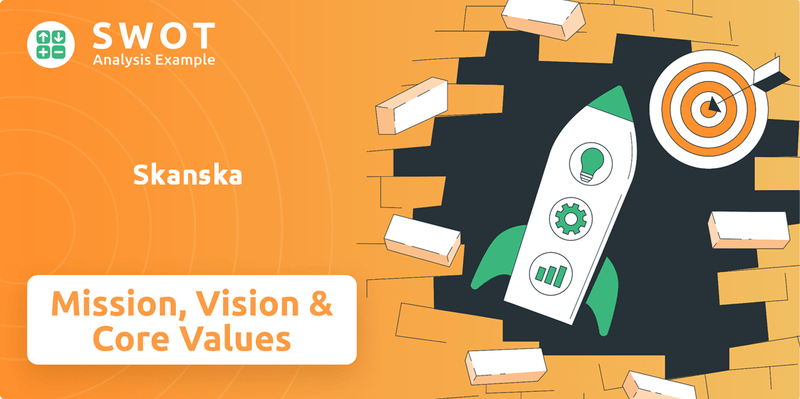
This analysis of Skanska SWOT Analysis will illuminate how Skanska's mission, vision, and core values translate into real-world actions and strategic decisions. We'll examine the company's commitment to sustainability, ethical practices, and long-term goals, offering insights into how Skanska integrates its vision into its diverse projects. Learn about the core values of Skanska construction and how they contribute to its success.
Key Takeaways
- Skanska's core principles drive success in construction and development.
- Sustainability, safety, ethics, and collaboration are central to Skanska's strategy.
- 'Building for a better society' and 'the five zeros' define Skanska's purpose.
- Alignment with values is key to navigating challenges and attracting talent.
- A clear corporate purpose is vital for long-term sustainability and impact.
Mission: What is Skanska Mission Statement?
Skanska's mission is 'to provide innovative and sustainable solutions to create a sustainable future for its people, customers, and communities.'
Let's delve into the core of Skanska's operational philosophy and explore how this mission statement shapes its actions and impacts the world.
The Mission, Vision & Core Values of Skanska centers on innovation and sustainability. This dual focus guides Skanska's strategic direction, influencing its project selection and operational practices. The goal is to benefit stakeholders, including employees, clients, and the broader community.
Skanska targets a diverse customer base. This includes individuals, businesses, and public entities. They offer a wide array of services, from building construction to infrastructure development, catering to various needs across Europe and North America.
Skanska actively integrates advanced technologies into its projects. This includes the use of Building Information Modeling (BIM) and digital project management tools. These technologies improve efficiency and enhance project outcomes.
Skanska's commitment to sustainability is evident in its green construction practices. They prioritize the use of sustainable materials and energy-efficient designs. For example, Skanska aims to achieve net-zero carbon emissions by 2045.
Skanska has made significant strides in reducing its environmental footprint. By 2024, the company reported a 61% reduction in Scope 1 and 2 emissions compared to 2015. Furthermore, they achieved a 37% reduction in Scope 3 emissions compared to 2020, demonstrating their commitment to lowering carbon emissions across their value chain.
Skanska's mission extends beyond environmental concerns to include social responsibility. They focus on creating positive impacts within the communities where they operate. This includes supporting local initiatives and promoting ethical business practices.
By focusing on these aspects, Skanska demonstrates how its mission translates into tangible actions that benefit both its stakeholders and the environment. The Skanska mission is a dynamic framework. It guides the Skanska company in its pursuit of sustainable development and innovation. The Skanska goals are aligned with its Skanska principles, showcasing a commitment to long-term value creation. Understanding the Skanska vision and Skanska core values provides a comprehensive insight into its operational philosophy.
Skanska SWOT Analysis
- Complete SWOT Breakdown
- Fully Customizable
- Editable in Excel & Word
- Professional Formatting
- Investor-Ready Format
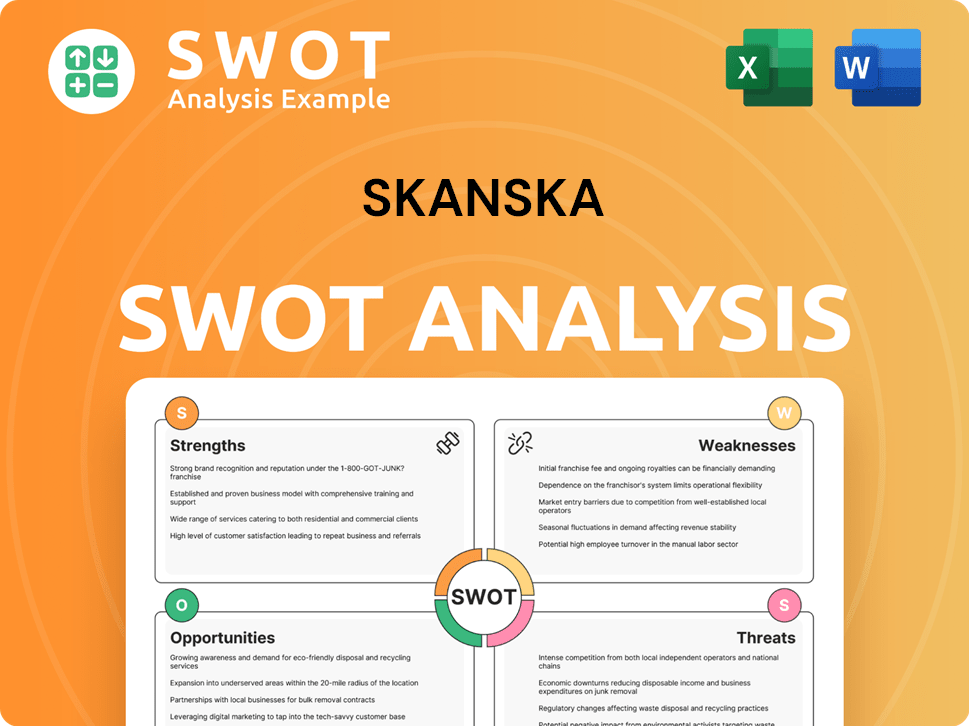
Vision: What is Skanska Vision Statement?
Skanska's vision is encapsulated in 'the five zeros': zero loss-making projects, work site accidents, environmental incidents, ethical breaches, and defects.
Skanska's vision, a cornerstone of the Skanska company, is ambitious and forward-thinking, aiming for perfection across key operational areas. This vision, known as 'the five zeros,' underscores Skanska's goals for continuous improvement and sets a high standard within the construction and development industry. Understanding the Skanska mission, vision, and values is crucial for anyone looking to engage with or invest in the company.
The 'five zeros' vision is aspirational, pushing Skanska towards eliminating negative outcomes. It's a long-term goal that drives strategic planning and operational excellence. This vision reflects Skanska's long-term vision for the future.
The vision covers financial performance, safety, environmental impact, ethical conduct, and quality. This comprehensive approach demonstrates Skanska's approach to corporate responsibility. It aims to create a positive impact across various dimensions.
The vision serves as a catalyst for continuous improvement initiatives. It encourages the company to identify and mitigate risks. This commitment is a key aspect of Skanska's commitment to sustainability and overall excellence.
Skanska's commitment is demonstrated through robust safety programs and adherence to its Code of Conduct. Investment in technology supports the reduction of defects and environmental incidents. These actions showcase examples of Skanska's mission in action.
While achieving absolute 'zero' is challenging, the vision provides a clear direction. It motivates strategic planning and operational execution. This long-term perspective is crucial for understanding Skanska's vision and values explained.
Skanska integrates its vision into every project it undertakes, ensuring that its core values are reflected in its operations. This integration is a key factor in how Skanska integrates its vision into projects.
The vision is not just a statement; it's a driver for innovation and investment. For instance, Skanska has invested heavily in digital tools and technologies to improve safety and reduce environmental impact. In 2024, Skanska reported a significant reduction in work-related incidents, demonstrating the effectiveness of its safety programs. The company's focus on ethical conduct, as outlined in its Code of Conduct, is another critical component of achieving its vision. Skanska's commitment to these principles is also reflected in its approach to its Target Market of Skanska. The company's emphasis on sustainability is also evident in its projects, with a growing number of green building certifications achieved annually. Understanding how Skanska integrates its vision into its operations is essential for investors and stakeholders. The vision, along with Skanska's core values, provides a framework for decision-making and guides the company's actions. The company's commitment to safety and ethics is a cornerstone of its operations, ensuring that it continues to build a sustainable future. The company's vision is a testament to its commitment to excellence and its desire to make a positive impact on the world. The core values of Skanska construction are integral to achieving this vision.
Skanska PESTLE Analysis
- Covers All 6 PESTLE Categories
- No Research Needed – Save Hours of Work
- Built by Experts, Trusted by Consultants
- Instant Download, Ready to Use
- 100% Editable, Fully Customizable
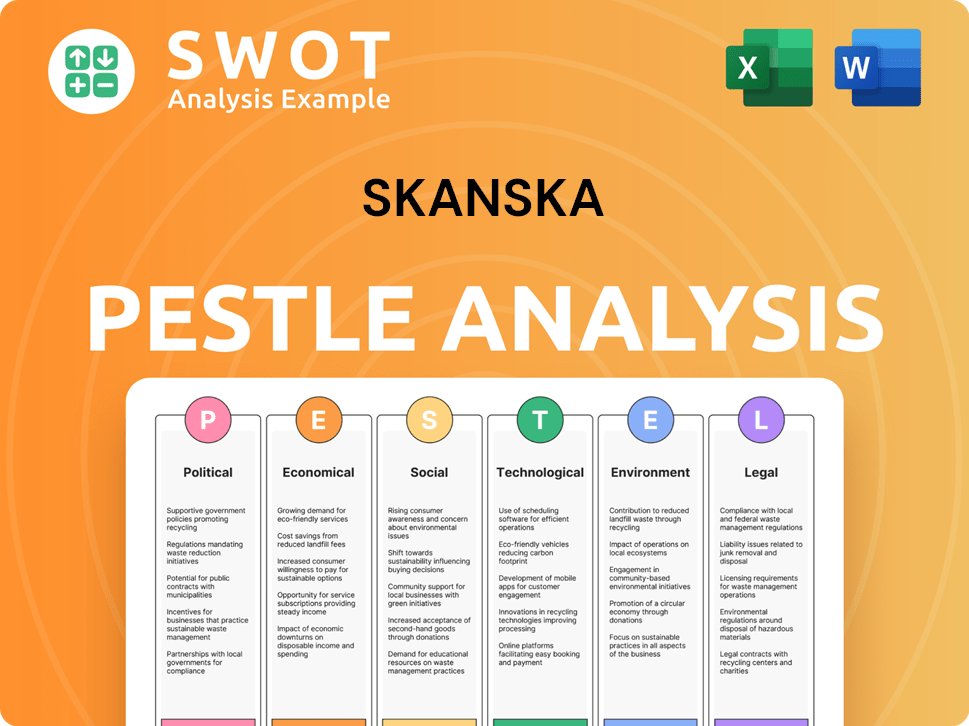
Values: What is Skanska Core Values Statement?
Understanding the core values of Skanska is crucial to grasping the essence of the Skanska company and its operations. These values serve as the bedrock of Skanska's identity, guiding its actions and shaping its interactions with stakeholders.
This value emphasizes Skanska's unwavering commitment to the safety and well-being of its employees, partners, and the environment. It is reflected in rigorous safety protocols on construction sites, the use of sustainable materials, and energy-efficient designs. Skanska's dedication to "Care for Life" is evident in its ongoing efforts to reduce workplace accidents and minimize its environmental footprint, aligning with the growing demand for responsible corporate practices. In 2023, Skanska reported a significant reduction in its Lost Time Incident Rate (LTIR), demonstrating the effectiveness of its safety initiatives.
Integrity, honesty, and transparency form the foundation of Skanska's ethical framework. This value is embedded in their Code of Conduct and influences all business practices, promoting fair competition and preventing corruption. Skanska's commitment to ethical conduct is further demonstrated through its robust compliance programs and regular audits, ensuring that all operations adhere to the highest standards of integrity. Skanska's commitment to ethical and transparent practices helps build trust with stakeholders, which is crucial for long-term success, as evidenced by the company's consistent high ratings in ethical business assessments.
Collaboration, teamwork, and inclusivity are at the heart of this value. It encourages employees to share knowledge and learn from each other, fostering a sense of belonging and shared purpose. This collaborative spirit extends to partnerships with customers, subcontractors, and communities, driving innovative solutions and ensuring project success. Skanska’s collaborative approach has led to several award-winning projects, showcasing the power of teamwork and shared expertise. The company's emphasis on "Be Better Together" also contributes to higher employee satisfaction and retention rates, as highlighted in recent internal surveys.
This value places the customer at the center of Skanska's operations, emphasizing active listening, understanding needs, and delivering solutions that exceed expectations. It drives the creation of innovative and sustainable solutions that address customer demands and market trends. This customer-centric approach fosters long-term relationships and builds a reputation for reliability and excellence. Skanska’s focus on customer satisfaction is reflected in its high customer retention rates and positive feedback on completed projects. This commitment is also a key element in Skanska's Growth Strategy.
These four core values of Skanska – Care for Life, Act Ethically and Transparently, Be Better Together, and Commit to Customers – collectively define the company's approach to business and its commitment to sustainability, safety, ethics, and customer satisfaction. Understanding these values is essential for grasping Skanska's mission and how it strives to achieve its goals. In the next chapter, we will explore how Skanska's mission and vision influence its strategic decisions.
How Mission & Vision Influence Skanska Business?
The Skanska mission and Skanska vision are not merely aspirational statements; they serve as the bedrock for the company's strategic decision-making processes. These guiding principles shape every facet of Skanska's operations, from project selection to technological investments.
Skanska's commitment to "innovative and sustainable solutions" and "building for a better society" directly influences its strategic priorities.
- Focus on Green Construction: Prioritizing projects that incorporate sustainable building practices and materials, aiming to reduce environmental impact.
- Investment in Digital Transformation: Implementing Building Information Modeling (BIM), AI, and robotics to enhance efficiency, safety, and sustainability.
- Geographic Focus: Concentrating resources in key home markets (Europe and North America) where Skanska can maximize its impact and leverage its expertise.
- Sustainable Property Development: Actively developing and investing in sustainable properties, such as LEED-certified buildings.
Skanska's digital transformation efforts are directly linked to its Skanska mission of sustainability and efficiency. The company is investing heavily in technologies like AI-powered project management tools to reduce waste and improve project outcomes. This commitment is reflected in their reported achievements, such as a 10% reduction in carbon emissions from their operations in 2023 compared to the previous year.
The "five zeros" vision (zero accidents, zero environmental incidents, zero ethical breaches, zero defects, and zero lost time injuries) provides clear, measurable targets that influence day-to-day operations and long-term strategic goals. Skanska's commitment to safety is evident in its continuous efforts to reduce lost time injury rates. For example, in Norway, Skanska reported a 20% decrease in lost time injury rates in 2024 compared to 2023, demonstrating the direct impact of their Skanska core values on workplace safety.
Skanska's success is measured by tangible outcomes that align with its mission and vision. Key performance indicators (KPIs) include reductions in carbon emissions, improvements in safety performance, and the successful delivery of complex, sustainable projects. The company's commitment to sustainability is also reflected in its financial performance. For instance, Skanska’s revenue from green projects has increased by 15% in the last two years, demonstrating the financial benefits of aligning with its values.
Skanska's focused approach to its home markets allows it to concentrate its expertise and resources on areas where it can have a significant impact and build for a better society. This strategic focus enables Skanska to build strong relationships with local stakeholders and tailor its projects to meet specific regional needs. This strategic focus has led to increased project wins in their core markets, with a 12% increase in new orders in North America in 2024.
The decision to invest in and develop sustainable properties, such as LEED-certified buildings, is a direct outcome of their commitment to sustainability. Skanska’s investment in green building projects has yielded significant returns, with LEED-certified projects often commanding higher market values and attracting environmentally conscious tenants. Skanska's commitment to sustainable development is also evident in its partnerships with organizations focused on green building practices, further solidifying its position as a leader in the industry.
Skanska actively engages with its stakeholders, including employees, clients, and communities, to ensure its actions align with its Skanska principles. This engagement fosters trust and collaboration, enabling Skanska to deliver projects that meet the needs of all parties involved. Skanska’s commitment to transparency and open communication, as outlined in their annual reports and sustainability disclosures, underscores their dedication to building strong relationships with all stakeholders. To learn more about the financial aspects of Skanska, you can read about Owners & Shareholders of Skanska.
In essence, the Skanska mission and Skanska vision are not just words; they are the driving force behind the company's strategic choices, influencing its investments, operational practices, and overall direction. These principles guide Skanska's commitment to sustainability, safety, and ethical conduct, shaping its long-term success and its impact on society. Next, we will delve into the core improvements to the company's mission and vision.
Skanska Business Model Canvas
- Complete 9-Block Business Model Canvas
- Effortlessly Communicate Your Business Strategy
- Investor-Ready BMC Format
- 100% Editable and Customizable
- Clear and Structured Layout
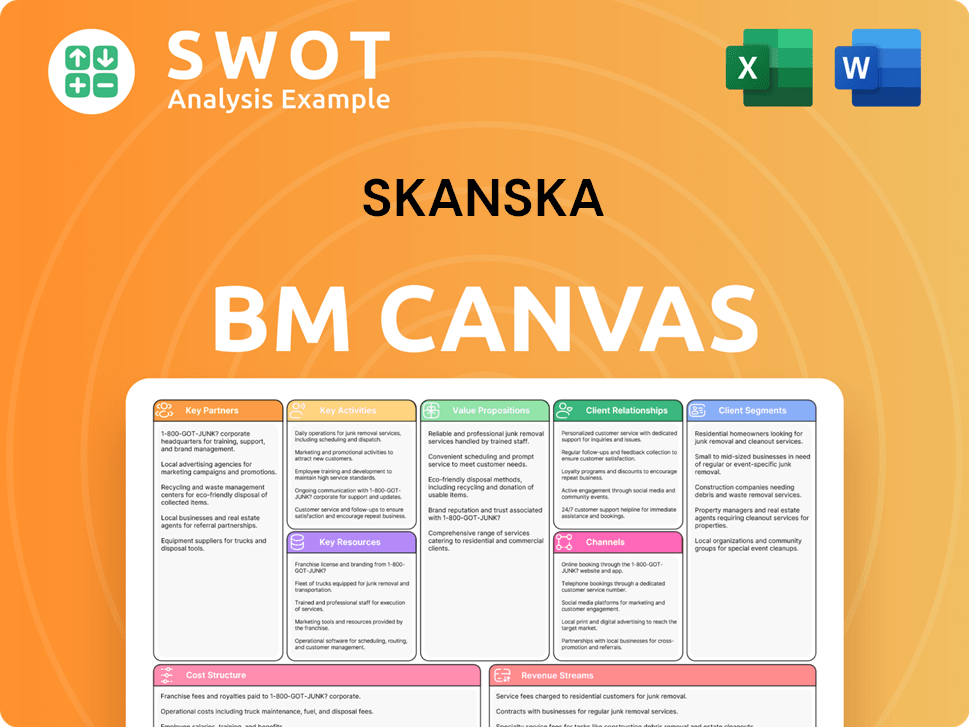
What Are Mission & Vision Improvements?
While Skanska's current statements are commendable, there's always room for enhancement, especially in a rapidly evolving world. This section explores four key areas where Skanska can further refine its mission and vision to better reflect its commitment to sustainability, social responsibility, and technological advancement.
To strengthen its commitment, Skanska could explicitly incorporate social equity and community development into its mission statement. This could involve adding a phrase like "and fostering thriving communities" to the existing mission, which currently focuses on building for a better society. This would more clearly articulate Skanska's dedication to creating positive social change alongside its construction projects, aligning with the growing demand for corporate social responsibility.
Skanska's vision currently focuses on "five zeros," including zero accidents and zero environmental impact. Expanding this to include a "zero social inequality" goal would acknowledge the company's role in creating equitable opportunities within the communities they operate. This could involve initiatives focused on diversity and inclusion, local job creation, and supporting underserved populations, further solidifying Skanska's commitment to its core values and long-term vision.
The construction industry is rapidly transforming with advancements in technology, including generative AI, and innovative construction materials. Skanska could strengthen its vision statement to reflect this, perhaps aiming to be a "leader in digital and sustainable construction." This would signal a proactive approach to embracing new technologies and methodologies, such as Building Information Modeling (BIM) and prefabrication, which can improve efficiency, reduce waste, and enhance project outcomes. For example, Skanska has already implemented digital tools that have led to a 15% increase in project efficiency and a 10% reduction in material waste on select projects.
Reviewing and refining the Skanska core values to ensure they resonate with employees and promote a strong sense of purpose can improve engagement. This could involve clarifying how the values translate into everyday actions and decision-making, and incorporating employee feedback into the process. For example, Skanska could highlight examples of how its core values, such as "Be Better Together," are demonstrated in the workplace, which can lead to a more inclusive and collaborative environment, and contribute to Skanska's mission. Understanding the Revenue Streams & Business Model of Skanska will help to understand how these values are implemented.
How Does Skanska Implement Corporate Strategy?
Implementing a company's mission, vision, and core values is crucial for translating strategic intent into tangible actions and outcomes. This chapter explores how Skanska, a leading global construction and development company, effectively puts its principles into practice.
Skanska's commitment to Skanska's mission and Skanska vision is strongly demonstrated through its sustainability initiatives. These initiatives are not merely aspirational but are integrated into its operational practices and business strategies.
- Net-Zero Carbon Emissions Target: Skanska has set an ambitious goal to achieve net-zero carbon emissions by 2045. This long-term vision underscores their dedication to environmental stewardship.
- Emission Reduction Progress: The company has made significant strides in reducing Scope 1, 2, and 3 emissions. These reductions are a direct result of implementing sustainable practices across its operations.
- Sustainable Materials and Designs: Skanska prioritizes the use of sustainable materials, energy-efficient designs, and low-carbon construction techniques in its projects. This includes the use of recycled materials and the adoption of innovative technologies.
- Project-Specific Sustainability Goals: Skanska integrates sustainability targets into individual projects, ensuring that each project contributes to the company's overall environmental goals.
Leadership plays a pivotal role in reinforcing Skanska core values and integrating them into the company culture. This top-down approach ensures that the mission and vision are consistently communicated and upheld throughout the organization.
The emphasis on safety, for instance, is driven from the top down, with leaders promoting a safety-first mindset and investing in safety programs. This commitment is evident in the company's safety performance metrics, which are closely monitored and continuously improved.
Skanska communicates its mission and values through various channels to all stakeholders. This ensures that everyone understands the company's principles and how they guide its actions.
The company website, annual reports, and internal communications are primary channels for disseminating information about its mission, vision, and values. This transparency builds trust and reinforces the company's commitment to its stakeholders.
Skanska demonstrates alignment between its stated values and actual practices through various initiatives and projects. These examples showcase how the company’s core principles are put into action.
Involvement in community investment projects and commitment to diversity and inclusion are concrete examples of Skanska's values in action. These initiatives reflect the company's dedication to social responsibility and creating a positive impact on society. For more insights, check out the Marketing Strategy of Skanska.
Skanska utilizes formal programs and systems to ensure alignment between its values and operational practices. These structured approaches help maintain consistency and drive progress toward Skanska goals.
The Sustainability Action Plan, Safety Leadership Program, and initiatives focused on innovation and diversity are key examples. The integration of data governance into their business management system also supports data-driven decision-making aligned with their goals.
Skanska Porter's Five Forces Analysis
- Covers All 5 Competitive Forces in Detail
- Structured for Consultants, Students, and Founders
- 100% Editable in Microsoft Word & Excel
- Instant Digital Download – Use Immediately
- Compatible with Mac & PC – Fully Unlocked
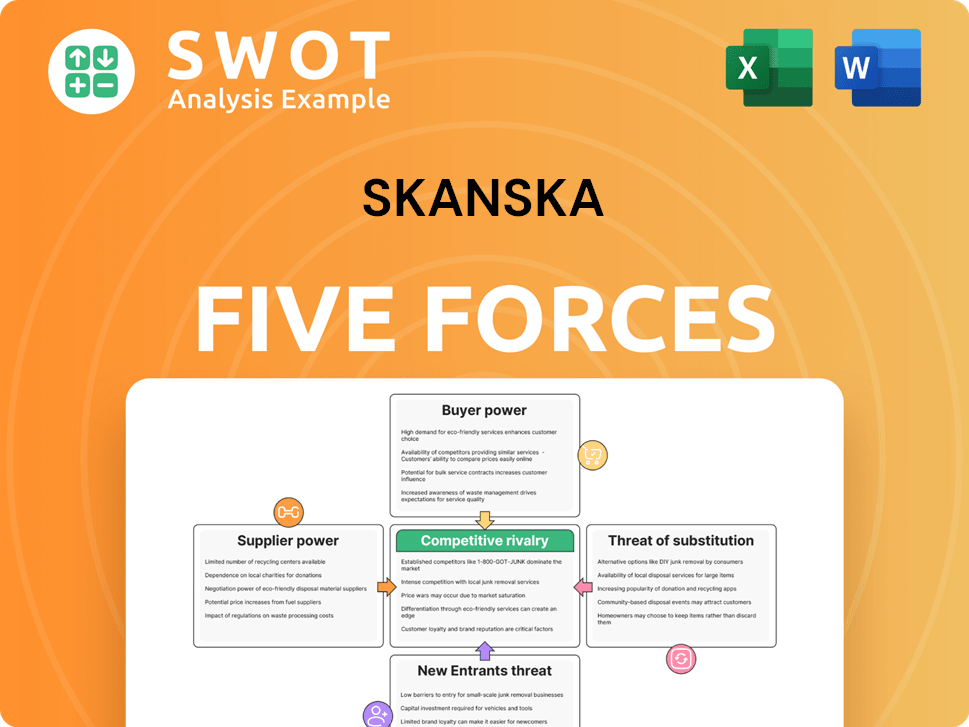
Related Blogs
- What are Mission Vision & Core Values of Skanska Company?
- What is Competitive Landscape of Skanska Company?
- What is Growth Strategy and Future Prospects of Skanska Company?
- How Does Skanska Company Work?
- What is Sales and Marketing Strategy of Skanska Company?
- Who Owns Skanska Company?
- What is Customer Demographics and Target Market of Skanska Company?
Disclaimer
All information, articles, and product details provided on this website are for general informational and educational purposes only. We do not claim any ownership over, nor do we intend to infringe upon, any trademarks, copyrights, logos, brand names, or other intellectual property mentioned or depicted on this site. Such intellectual property remains the property of its respective owners, and any references here are made solely for identification or informational purposes, without implying any affiliation, endorsement, or partnership.
We make no representations or warranties, express or implied, regarding the accuracy, completeness, or suitability of any content or products presented. Nothing on this website should be construed as legal, tax, investment, financial, medical, or other professional advice. In addition, no part of this site—including articles or product references—constitutes a solicitation, recommendation, endorsement, advertisement, or offer to buy or sell any securities, franchises, or other financial instruments, particularly in jurisdictions where such activity would be unlawful.
All content is of a general nature and may not address the specific circumstances of any individual or entity. It is not a substitute for professional advice or services. Any actions you take based on the information provided here are strictly at your own risk. You accept full responsibility for any decisions or outcomes arising from your use of this website and agree to release us from any liability in connection with your use of, or reliance upon, the content or products found herein.